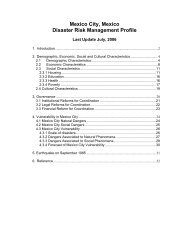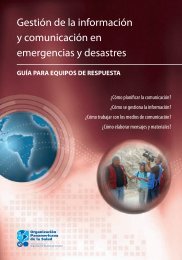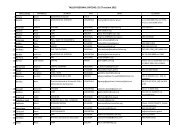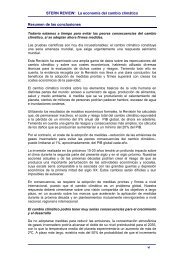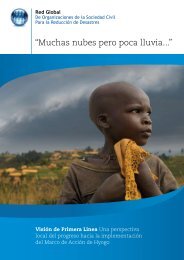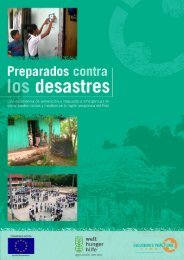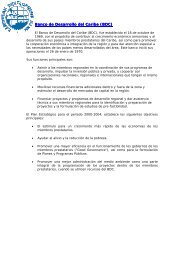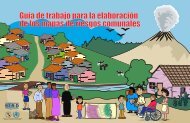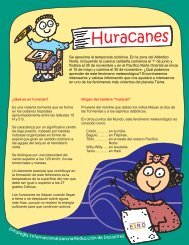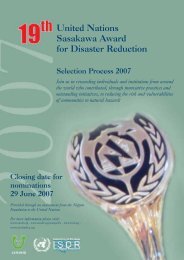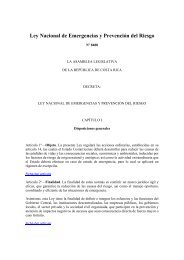Characteristics of a Disaster-resilient Community A ... - PreventionWeb
Characteristics of a Disaster-resilient Community A ... - PreventionWeb
Characteristics of a Disaster-resilient Community A ... - PreventionWeb
Create successful ePaper yourself
Turn your PDF publications into a flip-book with our unique Google optimized e-Paper software.
Version 1 (for fieldtesting), August 20072.4 Composite characteristicsSome characteristics are composites <strong>of</strong> individualcharacteristics – for example:[hazard/risk] assessment findings shared,discussed, understood and agreed among allstakeholders, and feed into community disasterplanning.This contains two main elements: (1) sharing,discussion, understanding and agreement aboutassessment findings among all stakeholders; (2)assessment findings feed into community disasterplanning. The first main element can also be split int<strong>of</strong>our more particular elements: sharing, discussion,understanding and agreement. One reason foraggregating characteristics in this way is to make thisdocument more manageable: without it, the tableswould be extremely long. But this has only been donewhere the different characteristics are strongly linkedto one another. In practice, and depending on whatpurpose they are using the tables for, organisationsmay wish to disaggregate some <strong>of</strong> the characteristics.2.5 Quantitative versus qualitativecharacteristicsThe characteristics set out in these tables arequalitative. Communities and their partners thereforeneed to make their own judgements about whether ornot certain aspects <strong>of</strong> resilience have been achieved.Some <strong>of</strong> these will be more straightforward thanothers. For instance, it is easy to tell if a communitydisaster preparedness or contingency plan exists (evenif its quality is another matter). But it is much harder todecide if there is an equitable distribution <strong>of</strong> wealthand livelihood assets in a community, or the adequacy<strong>of</strong> access to common property resources that cansupport coping strategies during crises.The guidance note cannot tell projects andcommunities how they should reach thesejudgements. They are matters for collective agreementbetween the stakeholders. The conclusions will bedifferent in each case, according to context andexpectations, and there will be a fair amount <strong>of</strong>subjective judgement. But in every case the processfor reaching decisions must be transparent andparticipatory.Some guidelines and experts have suggested theneed for quantitative indicators <strong>of</strong> certain aspects <strong>of</strong>DRR (e.g. the number <strong>of</strong> volunteers trained in first aid,the percentage <strong>of</strong> households in a community withproperty insurance). It is impossible to fix standardquantitative measures that can be applied to everycontext but quantitative indicators can be used at anindividual project level, if required. In such cases, theycould form part <strong>of</strong> the data on which the broaderjudgements about attainment <strong>of</strong> characteristics <strong>of</strong>resilience are based. It is for individual project teamsto decide what kinds <strong>of</strong> quantitative indicator areappropriate and what levels <strong>of</strong> attainment to set.3. <strong>Characteristics</strong> <strong>of</strong> an EnablingEnvironmentIn this guidance note, the focus is on communities andlocal organisations (although individual and householdresilience is incorporated in the tables to some extent).However, the framework acknowledges theimportance <strong>of</strong> wider institutional, policy and socioeconomicfactors in supporting community-levelresilience.The tables identify the main elements <strong>of</strong> this‘enabling environment’ 5 in relation to eachcomponent <strong>of</strong> resilience. They are less detailed thanthe characteristics <strong>of</strong> community resilience. Most aretaken from the national-level DRR indicatorframeworks being developed by UN ISDR and UNOCHA (see Further Reading).The following table (on page 12) illustrates how thisworks for one component <strong>of</strong> resilience. Note that itincludes local and national level characteristics.Elsewhere in the tables, international dimensions <strong>of</strong>the enabling environment are also sometimesincluded.People who work on community resilience need tobe conscious <strong>of</strong> the enabling environment and theeffect it may have on their work, but they cannot beexpected to analyse it in detail. An individual projectwill probably undertake a quick, subjective assessment<strong>of</strong> the enabling environment. However, anorganisation working on a number <strong>of</strong> communityprojects in a particular country – e.g. a national orinternational NGO – may wish to carry out a morethorough assessment to inform its work or to supportadvocacy.Many features <strong>of</strong> the ideal enabling environmentwill be missing in many cases. In some situations thelack <strong>of</strong> key components <strong>of</strong> support may be so greatthat it creates what may be called a ‘disabling’5 The term ‘enabling environment’ is borrowed from the All India <strong>Disaster</strong> Mitigation Institute. See ‘The Need for a More Nuanced View <strong>of</strong>Local Capacity and the Support Approaches <strong>of</strong> Outsiders’. southasiadisasters.net 2006 #18 (August), p.4.http://www.southasiadisasters.net/publication.htm The IFRC’s ongoing work on local-level DRR indicators uses a C-I-T categorisation toconsider this (where C = issues the community can change; I = issues the community can influence to find solutions; T = issues where thecommunity recognises that transformation will take a long time and is out <strong>of</strong> their hands): Barrena I 2007, ‘Indicators: A guide to find simpleindicators for risk reduction projects at local level’. (Geneva: IFRC, unpublished draft report).11





